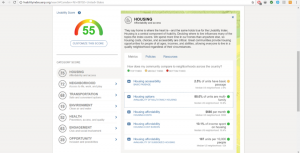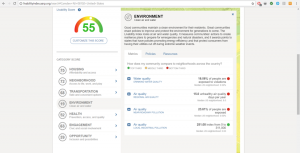I was recently at a meeting down in Washington for work and met with some extremely sharp folks doing very interesting work. One group in particular through AARP was discussing a new tool being developed called the Livability Index. Essentially this tool scores and ranks cities across the country based on an averaging score of seven distinct categories; these categories are housing, environment, transportation, health, neighborhood, opportunities, and engagement. You can enter any city in America and you’ll find an average score of the seven categories to detail that city’s level of “livability.” It’s a very interesting tool to play around with and search through various levels of conditions that exist around the country.
Obviously, I check Camden’s zipcodes (08102 – 05) and the Livability Index (LI) gave the city an average score of 55 out of a possible 100. To be honest, I was shocked for a few reasons. I wasn’t shocked by the score because it was more than 50% livable but because of two specific categories that attributed to the average score. For housing in Camden, the LI gave the city a 75 out of 100. Within each category there are subcategories that denote how a category score was deduced by using data and statistics to present a percentage of the city affected (either negatively or positively by this condition); this is specifically why I’m interested in the LI because it looks at city issues with a conditions lens. Each subcategory is given a green, yellow, or red indicator to show how close it is to the national average (in percentages).
For housing, there are five subcategories:
The most interesting subcategory to me was “housing affordability – housing costs” because this data analysis (in comparing costs to the median US neighborhood) seems a little tricky. Right off the bat, you can’t necessarily compare Camden, NJ to another US neighborhood because it’s unlike any other I’ve known in some many (great) ways. Then again, I suppose anyone could say that about their city but ours certainly does have something unique and special about it unlike any the rest of the country has truly witnessed. Second, housing costs are very case by case and they are also drenched with other policies, conditions, and otherwise that it can be very difficult to assess them correctly, and unfortunately in this case to very easily miscalculate. Thirdly, many of the units available in the city are actually either government or bank owned (475 out of 645 units available for purchase in the city based on Trulia) which makes them automatically less attractive to buy or invest. This leaves the rest of the homebuyer base essentially grabbing for air when it comes to (1) affordable (2) options for residences in Camden. What I’m wondering even more is just how far these scores go into the details of housing conditions themselves, outside of disability compliance. Is the electricity up to code? How is water getting into my home and are the pipes getting it there relatively new/lead-free/not wooden? When is the last time the roof or the foundation have been inspected by a general contractor or the city? These are all factors that play into how well and how accurately you can assess housing units and I don’t see that accounted for in the LI by simply standing up one monthly housing payment next to another. And it seems a little skewed anyway to have lower monthly costs for a home represent a better score because payments could be lower due to poorer conditions.
The other component of the LI score for Camden, which very sadly made more sense, was the environmental subcategory which factors for the city’s water and air qualities. Out of 100, Camden scored a 19; in comparison to the median US neighborhood, these numbers are pretty heartbreaking. Now this doesn’t just account for whether water or air “clean enough” as compared to the rest of the country, this also considers the questions of whether infrastructure is a factor in poorer quality water due to pipes and connections to city or county lines or industrial presence and influences that increase pollutants per million in the community’s air. It’s no secret that Camden’s infrastructure needs a lot of attention (I wrote an article a couple weeks ago about it) and I’m glad to see the LI consider these parts of a city’s overall livability.
Now I don’t say all of this to skeptically scoff away what seems to be a very promising tool for the new ways in which we can assess the conditions of our cities. What I’m concerned about, and I always have been about issues such as these when they crop up, is what do we do about it? Even with a Livability Index that accounted for poor housing conditions or air pollutants perfectly – what are you telling me that I don’t know already? Many people in this city constantly tell me (paraphrasing), “I’m not stupid. I know what’s wrong with my city, but no one wants to talk about what we can do to fix it.” Camden has consistently been poked and prodded by those with good intentions to learn about the disparities that exist in communities but far and few in-between do we see real work taking place from the data collected to turn the tide.
Housing policies are tricky and the economics are that much more difficult and fragile with the Economic Opportunity Act have such a profound presence in Camden. A shrunken tax base and a volatile school system are intrinsically tied to a poor housing market no matter where you, but especially here in Jersey. An amendment to such a policy that accounts for and subsidizes homeownership given the incredible shift in economic balance for a municipality affected by the EOA could be a start. It’s apparent that to fix roads in the city you must fix the pipes underneath, and many of the pipes in this city still need that attention. So, a more robust and assertive capital investment plan from the city having joint jurisdiction in agreement with county could expedite the process of attending to other parts of the city that have been overlooked or put at the end of the waiting list for decades. Real progress can be made here with a real hope for improving communities, a dash of pragmatism, and the courage to stand up to whatever politics say you should just sit down and be loyal.


“Thirdly, many of the units available in the city are actually either government or bank owned (475 out of 645 units available for purchase in the city based on Trulia) which makes them automatically less attractive to buy or invest. ” – This is not a great way to judge the ownership of home units and is patently false. Be careful with those kinds of assumptions.